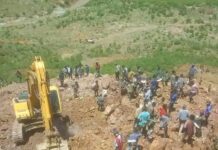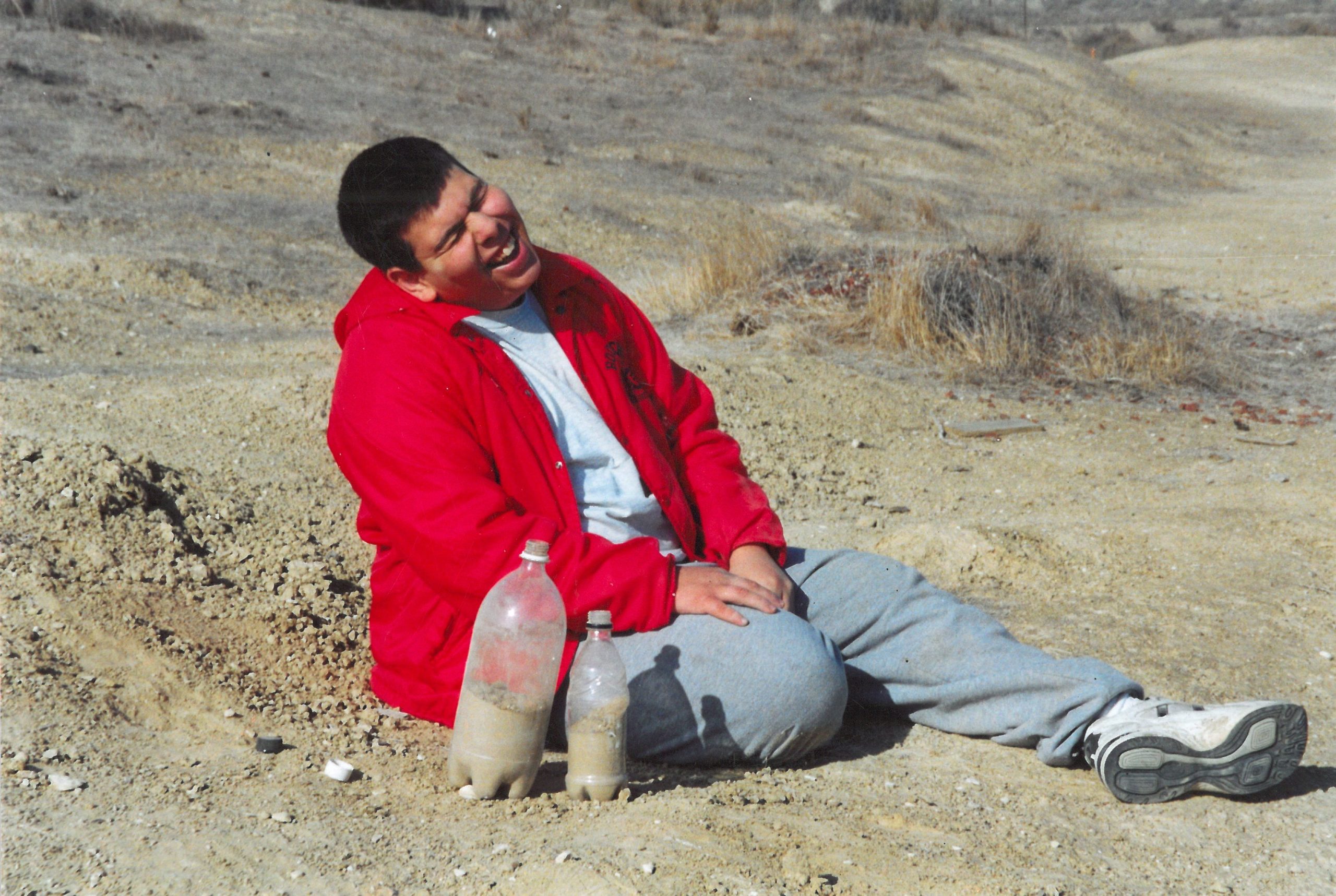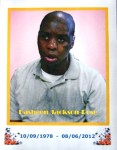By Lee Higgins
They grabbed him, gave him a sedative and tackled him in a hallway at the Bernard Fineson Developmental Center in Queens Village, New York. Rasheen Rose, who was moderately retarded and fiercely protective of his personal space, had a 250-pound staffer sitting on his 180-pound frame, in an apparent effort to stop his “assaultive” and “self-abusive” behavior.
As he struggled to breathe, Rose, autistic and unable to speak, could only point to the bathroom, where he often showered to relax. Staffers, however, didn’t get the message.
Rose died during a roughly ten-minute “prone restraint,” a technique considered physical abuse and banned in New York because of the “increased risk of respiratory distress and serious injury, including death.”
The cause of 33-year-old’s death on Aug. 6, 2012 was positional asphyxiation, according to the New York City Office of Chief Medical Examiner, which ruled Rose’s death a homicide. It took the center four months to report Rose’s death to the state Health Department authorities.
But when lawyers for Rose’s family met with Queens County prosecutors five months ago, they were told no criminal charges would be filed against the employee who restrained him, or nine others who, attorneys for the family said, failed to intervene.
“I don’t think this guy willfully wanted to kill Rasheen,” said Robert Santoriella, a lawyer representing Rose’s sister Shaniece Luke in a federal wrongful death lawsuit against the staff. “That’s why New York has manslaughter,” he said. “Was it reckless disregard? Absolutely.”
Rose is not alone. He is one of at least 24 developmentally disabled adults who have died after being restrained during the past 15 years, most at state-run residential facilities and state and privately-run group homes.
Of adult restraint deaths identified by 100Reporters through public records requests in 50 states and media reports, nine were ruled homicides, but charges were filed in only one of those cases.
An investigation into Rose’s death found no criminal conduct, said Kevin Ryan, a spokesman for the Queens County District Attorney’s office, adding that prosecutors weren’t notified about his killing until “approximately four months after the incident,” when it was ruled a homicide. The victims have left behind grieving families, who have often had to fight for justice in civil courts. Even there, some come up short.
“They didn’t just kill my baby,” said Pecola Campbell of Grand Rapids, Michigan, whose autistic son Roland was killed after being restrained at a group home in Lexington, Kentucky. “They killed me and the rest of my family.”
Violence Unchecked
Roland Campbell died in 2010 after two police officers and a worker restrained him. Campbell filed a federal lawsuit against those who killed her son. She questions why there isn’t more outrage over the deaths.

In Kentucky, there have been at least four deaths of handicapped patients due to excessive restraint in the past 15 years. The cause of Campbell’s 21-year-old son’s death was listed as “excited delirium,” but the manner of death – whether it was an accident or homicide- was never determined.
“When I see this happening, my heart breaks,” she said. “My pain comes back like it was just that day. I just don’t believe somebody can do that and mess up a whole family.”
Campbell, who raised her son until he was an adult, remembers teaching him how to hug her, by putting his arms around her neck. She recalls how he always smiled in the back seat as he looked out the window during long car rides through the countryside. Despite those fond memories, when she closes her eyes at night, she can’t help but picture him suffering in his final moments.
The lack of criminal accountability is not new, said Curtis Decker, executive director of the Washington, D.C.-based National Disability Rights Network, a non-profit advocacy group for disabled people. Prosecutors are reluctant to bring cases they fear they can’t win, relying heavily on staffers testifying against each other, he said. Developmentally disabled adults find themselves at the hands of staff that are poorly trained, low paid and subject to high turnover, despite having hundreds of thousands or more allocated each year through Medicaid for their care.
Earlier this year, Rose’s estate was billed by the state Office for People with Developmental Disabilities (OPWDD) for roughly $11.67 million – an estimate of his total Medicaid assistance for 10 years. His family viewed it as retaliation for filing suit, and the bill was withdrawn.
The Medicaid bills suggest that Rose’s facility collected more than $1 million a year for his care. Still, the facility could not verify annual CPR training for staff, according to an investigation by OPWDD’s Office of Investigations and Internal Affairs. Lawyers for Rose’s family also said that the air conditioning was not working on the day that Rose was assaulted.
“Folks are abused or killed and there’s very little in the way of repercussions after police and prosecutors just don’t bother,” said Decker. Employees conclude they are unlikely to face punishment, and can act with impunity, said Decker, who called for “more aggressive prosecutions, more thorough investigations.” These, he said, would send a message that “someone is watching.”
The prone restraint
At least 16 of the disabled adults who died were held face down in a prone restraint. The technique has been banned in Kentucky, at facilities operated by the Colorado Department of Human Services and in Ohio, which cited the risk of “sudden death.” According to the Autism National Committee, prone restraints are specifically banned in 10 states for all children and 11 for children with disabilities.
The chokehold death of 43-year-old Eric Garner by a New York City police officer in July has highlighted the risk of dangerous restraint techniques. Garner, who peddled loose cigarettes on a Staten Island street, died after challenging police, who threw him face down on the ground.
[quote align=”left” color=”#999999″]“They didn’t just kill my baby. They killed me and the rest of my family.” -Pecola Campbell[/quote]
A 2011 “National Review of Restraint Related Deaths of Children and Adults with Disabilities” by Equip for Equality, a nonprofit advocacy group, found that restraints were overused, often with insufficient cause. After examining 61 deaths of disabled people in various settings during the prior decade, the report found that one-third of incidents failed to meet the legal standard for using a restraint, meaning the victims did not pose an imminent danger to themselves or others. Data released in 2012 by the U.S. Department of Education showed that of 38,792 students physically restrained during the 2009-10 school year, 69 percent had disabilities, even though they represented just 12 percent of the population surveyed.
“The danger is, if you sit on the chest, you cannot expand your chest and inhale there,” said Dr. Werner Spitz, a St. Clair Shores, Michigan-based forensic pathologist, with more than five decades in the field. The chest has to be able to move in order to move the diaphragm.” It can take as few as three minutes for someone in a prone restraint to have difficulty breathing, he said. Patients with more fat in the abdominal area are at a heightened risk, he said. The more patients struggle, Spitz said, the more oxygen they need.
In a report on Rose’s death, a Dr. Ching Chiu, who prescribed the sedative, wrote that Rose continued to “roll and fight” during the restraint. Asked whether that was normal, Spitz said, “It’s very normal. It’s called air hunger. They’re fighting to breathe, that’s what they’re doing…When you put pressure on anybody’s neck or chest, they get violent. A person does not tolerate not being able to breathe. Certainly, not for long.”
J.J. Wohlers of Grand Island, Nebraska, a paramedic and expert witness in positional and restraint asphyxia, said that patients who end up in a prone restraint should immediately be turned to their side, so they can breathe. Keeping someone in a prone restraint for a lengthy period of time is “ridiculous” and demonstrates a lack of training, he told 100Reporters.
Group home staffers, he said, sometimes take assaults by residents personally and overreact. They conclude a patient is faking distress, and fail to check vital signs.
“They get carried away because everyone loses track of time and how much energy is being exerted by a person if they’re fighting against someone trying to restrain them,” he said. “People do get that mob mentality if you get four or five people going…It’s called dog pile.”
Fragile X, Deadly Hold
Joseph Adam Lynch, 27, who had Fragile X syndrome, a genetic condition that left him mentally retarded, was pinned down by several staffers after punching a manager in the face at the Mountain View Ranch Residential Care home in Bakersfield, California.
Lynch, who was angry about having to sign out for a cigarette break, was jammed in the corner of the kitchen and held in a prone restraint by the manager and two other staffers for about 15 minutes. Less than four minutes into the hold, Lynch stopped struggling, Kern County Sheriff’s Office records show, but none of the staffers performed CPR as they waited for sheriff’s deputies on July 9, 2013. Surveillance video shows staffers pinning Lynch down long after he had stopped moving, while others saunter in, wash dishes and take pictures with their cellphones.
When deputies tended to Lynch, his face was blue. They worked unceasingly to resuscitate him with C.P.R., as did firefighters, pumping down on his chest for more than 30 minutes, to no avail. Lynch died of positional asphyxia and his death was ruled a homicide, the Kern County Coroner’s Office found. No charges have been filed.
In a wrongful death lawsuit against staffers involved and Nankil Enterprises, Inc., which operates the group home, Lynch’s mother, Loida Lynch, alleges the restraint was used to punish her son for hitting the manager and amounted to criminal dependent adult abuse.
The family said in a statement that they were “deeply saddened and disturbed” over his death. Adam Lynch will “forever be remembered in our hearts as a caring and fun-loving young man who always enjoyed spending time with his family and was a diehard Pittsburgh Steelers and San Francisco Giants fan.”
“As a result of Adam’s death, we have lost trust in these groups’ care for the developmentally disabled,” the family said in a statement through its lawyer, Matt Clark, in announcing its lawsuit last December. “Our hope is that this lawsuit will prevent incidents like this from occurring in the future so that no other family has to go through the pain and suffering that we have had to endure during the past several months.”
Officials at Nankil Enterprises, Inc. in Bakersfield did not respond to messages seeking comment.
Longstanding Problem
Damien Patrick was dismayed to learn that prone restraint deaths are continuing, 13 years after his brother, Billy Patrick, who was mildly retarded, died at the Verbank Group Home in Verbank, New York. Group home staffers, he said, do not seem to care for residents and are unfit for the work.
“People lose their patience,” he said. “They lose their temper…These are handicapped individuals who did not deserve this in any way.”
In 1999, staffers restrained 35-year-old Billy Patrick, who threw up and then choked on his vomit. Patrick turned blue and required CPR to be resuscitated. He landed in a hospital, but the home never told his family about the restraint or a doctor’s order that Patrick not be restrained again. Two years later, he was held down again.
This time, Billy Patrick did not survive. Staffers had come to his bedroom to ask him about a dispute with another resident that they had heard about. Patrick got frustrated and swung his arms at one of them, court records show.
“They flat out grabbed him and threw him down and stuck his arm in his mouth and held him until he couldn’t move anymore,” said Damien Patrick, 37, of Rhinebeck, adding that his brother had a bite mark on his arm.
“His medical report clearly stated that he is not to be restrained again for the fact that he could die. It’s like, ‘Holy Cow,’” said Damien Patrick. “We got him back and then you restrain him again and kill him. That’s clearly negligence.”
Billy Patrick, who had stopped moving about five minutes into the hold, died of asphyxia during restraint and the death was ruled a homicide, according to the Duchess County Medical Examiner’s office. No charges were filed. In 2005, his family was awarded $500,000 after winning a civil lawsuit they filed against the state, alleging excessive force and inadequate training of staffers.
Damien Patrick doesn’t believe anyone set out to kill his brother, but said they crossed a line. “I personally believe they were trying to restrain him, but were doing it in a manner they were being abusive to him,” he said. “I believe they should have been charged.”
Patrick said developmentally disabled people are often viewed as “takers,” but his brother contributed to society, working at a factory assembling makeup kits and putting toys in plastic capsules for vending machines. Beyond that, he taught people what was important in life.
“I say to people that a handicapped person brings you back into the reality of pure love,” he said. “They don’t want anything, but your pure love and attention sometimes,” Patrick said. “You didn’t have to do anything special, but just spend time with him.”
Better Options
Wohlers, the restraint expert witness, said there are various alternatives to prone restraints including altering medication, using soft four-point restraints, temporarily using handcuffs or putting someone in a padded room. It is important to analyze why someone was restrained and to develop a plan to prevent it from happening again, he said.
David Fray, chief of the Hawaii Department of Health’s Developmental Disabilities Division and former director of Developmental Disability Services in Arkansas, said restraints should be avoided whenever possible because “you psychologically scar people, so you’re actually dehumanizing people.”
In Hawaii, he said, there have been no restraint deaths in the past 15 years and he suspects that is, in part, because few residents are placed in group homes. Of 2,500 developmentally disabled adults in the state, only 80 live in group homes, with the rest living with their own families or foster families.
He believes the group home model is flawed, putting residents on regimented schedules, making them share a bathroom and live in tight quarters. Residents need to be able to make their own decisions, he said.
“The first thing you teach people to do is back away,” he said. “Don’t be a threat. Create space,” Fray said. “When you take the control out of the equation, when you don’t try to control people, they really do pretty well.”
Joseph Adam Lynch, who was killed after staffers pinned him down at the Mountain View Ranch Residential Facility in Bakersfield, California. Family photo.














[…] From 100Reporters: […]
[…] http://100r.org/2014/10/terminal-restraint-disabled-adults-killed-when-caretakers-pile-on/ […]
A few corrections to your article:
First, prone restraint has not been banned in OH or KY. Colorado DHS still uses prone restraint regardless of any policy.
Second, NY on the other hand has required its state owned and licensed facilities to use specific programs because NY is hiring friends and cronies to provide training and overbill Federal grant programs. In any event, NY’s program used at DD facilities do not teach prone restraint. Interestingly enough, NY has one of the highest restraint prone fatality rates at their DD facilities because they do not teach prone restraint. What happens is that the program NY uses is insufficient to maintain safety so staff are placed in positions where they are confronted with a client that cannot be safely managed using NY’s program and are left to their own devices on how to maintain a safe environment. In NY, this is a failure to train issue, not a prone restraint issue.
Third, couldn’t you get a real expert. JJ Wohlers took over from Charly Miller because Miller was disqualified as an expert in multiple forums. He knows as little as she did. None of the scientific evidence done by real doctors show any issue regarding respiration while a person is in a prone position. So the issue is about pile-ons, not prone. In fact people who sleep on their stomach get more oxygen than people who sleep in other positions.
You should issue a correction regarding assertion of states that banned prone as the statement is incorrect and you should really try to get qualified experts.
References
Chan, T. C., T. Neuman, T. Calusen, J. Eisele, and G. M. Vilke (2004). Weight force during prone restraint and respiratory function. American Journal of Forensic Medicine and Pathology, 25: 185-189.
Chan, T.C., G.M. Vilke, T. Neuman, and J.L. Clausen (1997). Restraint asphyxiation and positional asphyxiation. Annals of Emergency Medicine, 30:578-586.
Glatter, K. and S.B. Karch (2004). Positional asphyxia: inadequate theory? (letter).
Forensic Science International, 141:2010-202.
Herd, J.A. Cardiovascular response to stress. The American Physiological Society, 71: 305-330.
Krauskopf, A., M.M. Mayerhoefer, F. Obernodorfer, B. Salemeh, A. Bur, B. Schneider, and D. Risser (2008). Does weight force application to the lower torso have an influence on inferior vena cava and cardiovascular parameters? American Journal of Emergency Medicine, 26:603-607.
American Journal of Forensic Medicine and Pathology, 14:86. Laposata, E.A. (1991). Levitzky, M.G. (1995). Pulmonary Physiology, 4th ed. McGraw-Hill, NY.
Michalewicz, B.A., T.C. Chan, G.M. Vilke, S.S. Levy, T. Neuman, and F.W. Kolkhourst (2007). Ventilatory and metabolic demands during aggressive physical restraint in healthy adults. Journal of Forensic Sciences, 1:171-175. Neuman, T. (2006). Positional and Restraint Asphyxia, In Ross, D. L. and Chan, T.C., Sudden deaths in custody, ed. 39-57). Humana Press, Totowa, NJ.
Parkes, J. (2000). Sudden death during restraint: A study to measure the effect of restraint positions on the rate of recovery from exercise. Medicine Science and the Law, 1: 39-44.
Reay, D.T., J.D. Howard, C.L. Flinger, and R.J. Ward (1988). Effects of position restraint oxygen saturation and heart rate following exercise. American Journal of Forensic Medicine and Pathology, 1:16-18.
Schmidt, P. and T. Snowden (1999). The effects of positional restraint on heart rate and oxygen saturation. The Journal of Emergency Medicine, 17:777-782.
Findings of experimental six studies contribute to clarifying the science behind restraint physiology (Chan et al. 1997; Schmidt and Snowden, 1999; Parkes, 2000; Chan et al, 2002; Chan et al. 2004; Michalewciz et al. 2007). Despite the obvious and apparent limitations associated with laboratory experiments with human subjects, these studies followed rigorous experimental methodological design, used randomization of respondents with trial applications, used appropriate statistical analysis and probability values, medically pre-screened participants, required subjects to exercise or struggle prior to restraint, and followed appropriate human subject research protocols.
The studies do not support the contention that ventilation is significantly comprised, regardless of being placed prone and restrained; being restrained hogtied or placed in a prone position, with or without weight on the back; or restrained, hogtied, and exposed to pepper spray. From a medical perspective, these studies reveal that there is no evidence that the hogtied position, in and of itself plays a risk factor for asphyxia. Collectively, the studies conclude that the prone restraint position, nor the hogtied restrained position, with or without weight force, contributed to abnormal pulmonary function, hypoxemia (deficient oxygenation of the blood), hypoventilation (decreased lung ventilation), or hypercapnia (excessive amounts of carbon dioxide in the blood) sufficient to cause asphyxia. Moreover, the findings are supported by prior work on exercise physiology which indicates that arterial oxygenation improves rather than decreases with moderate exercise in healthy people (Levitzy, 1995; Wasserman, et al. 1994).
The physiological science of restraint not only clarifies that the restraint position or restraint procedures fail to support a sudden death from ventilatory compromise but also reveal that other more significant factors are more likely to contribute to a sudden violent restraint death. Other factors such as excited delirium, drug intoxication, mental illness, stress, trauma, and catecholamine hyperstimulation, are considered to be factors playing the most significant role in these sudden deaths (Ross, 1998; Ruttenber, et al., 1997; Wetli, 2006, 2005; Laposata, 1993; Karch, 2008; DiMaio and DiMaio, 2006). Moreover, other studies show that a significant number of individuals who suddenly die after restraint have an abnormally enlarged heart, linked to chronic drug abuse, and have internal organ deficiencies (Herd, 1991; Karch, 2008; Karch and Green, 1995; Karch and Stevens, 1999; Laposata, 1991, 2006).
Thanks for the comment. Prone restraints were banned in Ohio roughly six years ago and previously banned in Kentucky after a number of restraint deaths. They are also explicitly banned in New York. As you can see, in the Rose case, it was a single staffer who restrained him and not a pile on situation.
[…] The entire story might be learn right here: Terminal Restraint: Disabled Adults Killed… […]
[…] The entire story could be learn right here: Terminal Restraint: Disabled Adults Killed… […]
[…] The complete story can be read here: Terminal Restraint: Disabled Adults Killed… […]
[…] being restrained, most of them residential facilities and group homes, according to 100 Reporters. Nine of those were ruled homicides, yet charges were filed in only one of those cases. According to one disability rights advocate, “prosecutors are reluctant to bring cases they […]
[…] being restrained, most of them residential facilities and group homes, according to 100 Reporters. Nine of those were ruled homicides, yet charges were filed in only one of those cases. According to one disability rights advocate, “prosecutors are reluctant to bring cases they […]
[…] being restrained, most of them residential facilities and group homes, according to 100 Reporters. Nine of those were ruled homicides, yet charges were filed in only one of those cases. According to one disability rights advocate, “prosecutors are reluctant to bring cases they […]
[…] being restrained, most of them residential facilities and group homes, according to 100 Reporters. Nine of those were ruled homicides, yet charges were filed in only one of those cases. According to one disability rights advocate, “prosecutors are reluctant to bring cases they […]